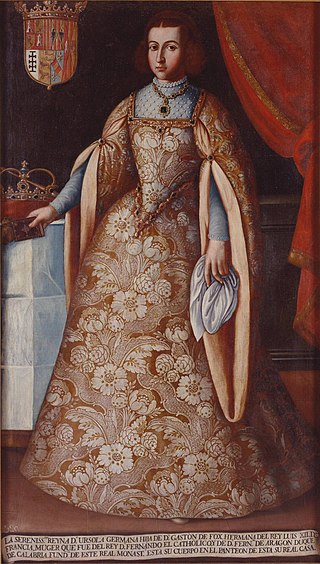
The House of Habsburg, also known as the House of Austria, is one of the most prominent and important dynasties in European history.

Ferdinand is a Germanic name composed of the elements farð "journey, travel", Proto-Germanic *farthi, abstract noun from root *far- "to fare, travel", and nanth "courage" or nand "ready, prepared" related to Old High German nendan "to risk, venture."
Ferdinand I or Fernando I may refer to:

The Kingdom of Naples, also known as the Kingdom of Sicily, was a state that ruled the part of the Italian Peninsula south of the Papal States between 1282 and 1816. It was established by the War of the Sicilian Vespers (1282–1302), when the island of Sicily revolted and was conquered by the Crown of Aragon, becoming a separate kingdom also called the Kingdom of Sicily. This left the Neapolitan mainland under the possession of Charles of Anjou. Later, two competing lines of the Angevin family competed for the Kingdom of Naples in the late 14th century, which resulted in the death of Joanna I by Charles III of Naples. Charles' daughter Joanna II adopted King Alfonso V of Aragon as heir, who would then unite Naples into his Aragonese dominions in 1442.

Francis I of the Two Sicilies was King of the Two Sicilies from 1825 to 1830 and regent of the Kingdom of Sicily from 1806 to 1814.
Ferdinand III may refer to:
King Ferdinand may refer to:

Ferdinand IV, Grand Duke of Tuscany was the last Grand Duke of Tuscany from 1859 to 1860.

The coat of arms of Spain represents Spain and the Spanish nation, including its national sovereignty and the country's form of government, a constitutional monarchy. It appears on the flag of Spain and it is used by the Government of Spain, the Cortes Generales, the Constitutional Court, the Supreme Court, and other state institutions. Its design consists of the arms of the medieval kingdoms that would unite to form Spain in the 15th century, the Royal Crown, the arms of the House of Bourbon, the Pillars of Hercules and the Spanish national motto: Plus Ultra. The monarch, the heir to the throne and some institutions like the Senate, the Council of State and the General Council of the Judiciary have their own variants of the coat of arms.

Ursula Germaine of Foix(c. 1488 – 15 October 1536) was an early modern French noblewoman from the House of Foix. By marriage to King Ferdinand II of Aragon, she was Queen of Aragon, Majorca, Naples, Sardinia, Sicily, and Valencia and Princess of Catalonia from 1506 to 1516 and Queen of Navarre from 1512 to 1516. She was Vicereine of Valencia from 1523 until her death in 1536, jointly with her second and third husbands, respectively Johann of Brandenburg-Ansbach and Ferdinand, Duke of Calabria. By her third marriage, she was Duchess of Calabria.

The Herzgruft is a burial chamber that protects 54 urns containing the hearts of members of the House of Habsburg. The crypt is located behind the Loreto Chapel in the Augustinian Church within the Hofburg Palace complex in Vienna, Austria.
Don Carlos of Spain or Infante Carlos of Spain may refer to:

Luisa of Naples and Sicily was Grand Duchess of Tuscany as the wife of Ferdinand III, Grand Duke of Tuscany. She was born a princess of Naples and Sicily as a daughter born to Ferdinand I of the Two Sicilies and Maria Carolina of Austria.

Maria Clementina of Austria was an Austrian archduchess and the tenth child and third daughter of Leopold II, Holy Roman Emperor and Maria Luisa of Spain. In 1797 she married her double first cousin Prince Francis, Duke of Calabria, heir to the kingdoms of Naples and Sicily. She was modest, well educated and kind, becoming popular in her adoptive country. Afflicted with frail health, she died of tuberculosis, age twenty four. Her only surviving child was Princess Caroline, Duchess of Berry.

Charles V, Holy Roman Emperor was the heir of several of Europe's leading royal houses. In 1506, he inherited the Burgundian Netherlands, which came from his paternal grandmother, Mary of Burgundy. In 1516, Charles became the king of Spain, inheriting the kingdoms first united by his maternal grandparents, Isabella I of Castile and Ferdinand II of Aragon. Finally, on the death of his paternal grandfather in 1519, Maximilian I, Holy Roman Emperor, he inherited the Habsburg lands in central Europe and was elected Holy Roman Emperor.

Ferdinand II was King of Aragon from 1479 until his death in 1516. As the husband of Queen Isabella I of Castile, he was also King of Castile from 1475 to 1504. He reigned jointly with Isabella over a dynastically unified Spain; together they are known as the Catholic Monarchs. Ferdinand is considered the de facto first king of Spain, and was described as such during his reign, even though, legally, Castile and Aragon remained two separate kingdoms until they were formally united by the Nueva Planta decrees issued between 1707 and 1716.
Prince Ferdinand may refer to:
This page is based on this
Wikipedia article Text is available under the
CC BY-SA 4.0 license; additional terms may apply.
Images, videos and audio are available under their respective licenses.











